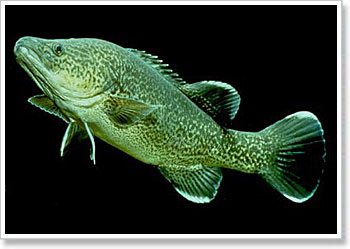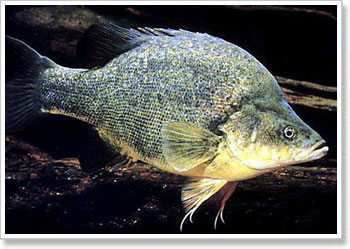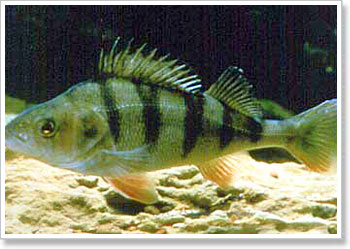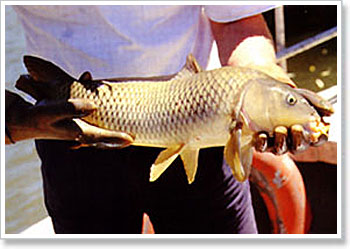
Fishing in the Murray River offers a variety of fish species
Murray River Fishing
Fresh Water Fishing Guide | Bait
Freshwater fishing and Guide for the Murray River - NSW/Victoria
Recreational fishing licence fee - NSW
Recreational fishing in the Murray River - South Australia
This information reproduced from "River Murray Fishing and Boating Guide"
Fish Species |
The Murray river plays host to many species of fish and apart from the regulars such as Murray Cod, Callop, Catfish, Bream, Macquarie, Perch and Redfin, there are a large number of assorted fish which are largely unknown.
For instance there are Gudgeon, Tupong, Freshwater Sunfish, Pigmy Perch, Line-eye Gudgeon, Tcheri or Hairback Herring, Silver Perch, Blackfish, Trout, (both Brown and Rainbow) Carp, Tench and many types of native Trout.
One of the challenges for native fish are the European Carp. If you catch a Carp you cannot return it to the river and will be fined if caught. They are a pest which destroys river quality and fish habitats.
| TOP |
Murray Cod
 The Murray Cod Grows to 1.8 metres and up to 113kg (Australia's largest freshwater fish)
The Murray Cod Grows to 1.8 metres and up to 113kg (Australia's largest freshwater fish)- They are found in the Murray - Darling systems (Endemic to Australia).
The Murray Cod is a renown sporting fish that is groper like in appearance and has a huge mouth. Its back is a mottled, olive-green colour and its belly is a silvery white. Edges of all soft fins may also be tipped in white. This species makes a facinating display and is at its best when housed in a large tank with natural mangrove roots as decoration. The natural feeding time of the Murray Cod is in the evening.
Murray Cod are a bottom feeding fish in the fresh water Darling-Murray system of Queensland, New South Wales, Victoria, and South Australia. It was introduced to Western Australia many years ago but it has not thrived in the manner it does in the Murray-Darling basin.
It can be taken from a moored or drifting boat or with a lure trolled behind the boat at speeds no greater than 2 knots.
They are strong hard fighters whilst they are in deep water and as they are pulled toward the surface they rapidly throw in the towel and, as a result, have become classified by fresh water anglers as sluggish, heavy fish and of no sporting value.
The breaking strain of the suitable line is usually far larger than it need be, particularly if a hand-line is to be used and lines with the dimensions of tennis racquet nylon are generally favoured. This, to a large degree, overcomes cut fingers.
If, however, a short boat rod is to be used, with either a large centre pin, side cast or multiplying reel, then a line with a breaking strain of 40 to 50 lbs. is more than adequate, Hook sizes would depend on the size of the fish one expects to encounter and anything from a 1/0 to 8/0 would be equally suitable. You must appreciate that Murray Cod is known to attain a weight of over 200lbs and even a fish of 100lbs could swallow comfortably a bait presented on the largest shark hook. There are three particular spinners which stand out that are by far the most successful.
They are:
- The Aeroplane spinner which has been proved over the years as the largest Cod taker in Australia.
- More recently there has been introduced large Sway Back, Flopy and Flatfish patterned models which are doing a first-class job.
- In the lower reaches of the rivers, however, the big 4 rubber Vivif is on its own and preferably of a green and red colour.
A word of warning, however, the standard hook supplied with this lure is not strong enough for large Cod and heavier trebles should be fitted.
If natural bait is to be used, an endless choice is available but the more successful are Yabby, Bardie, Grub, Shrimp, fresh water Mussel or Red Meat. The table value of Cod is well known, in fact, it ranks with the first 10 fish common to this country. Personally, I believe this to be and unjust classification, for unless you remove all the fat which gathers beneath the skin and along the walls of the stomach, the flesh is inclined to become oily. If a Cod is cut into cutlets, skinned, the fat removed then it will store for an indefinite period in a refrigerator with no loss of value as a food.
| TOP |
Callop also known as Yellowbelly, Murray Perch or Golden Perch
 Callop are normally bottom feeding fish found in the fresh water rivers of the Murray-Darling system in New South Wales, Victoria, South Australia and Queensland. In addition they occur in southern Western Australia, where they were introduced many years ago.
Callop are normally bottom feeding fish found in the fresh water rivers of the Murray-Darling system in New South Wales, Victoria, South Australia and Queensland. In addition they occur in southern Western Australia, where they were introduced many years ago.
They have been known to attain a weight in excess of 11 lb. and are highly respected by fresh water anglers for their ability to fight strongly until the end. When handled by an unwary angler the Callop can inflict sever wounds to fingers because the edge of the gill cover is razor sharp.
Usually taken from the bank of the river or in a drifting boat, Callop can also be taken by slowly trolling an artificial lure close to the bottom at speeds not exceeding 2 knots. The breaking strain of the line used is usually far more than necessary because Callop are found in exactly the same water as the Murray Cod and these grow to enormous proportions.
The angler never knows which fish he will get so lines of 20 to 40 lb. B.S. are adequate. The most suitable reel is either the bait casting or threadline reel and if used on a bait casting or threadline rod (with a length of 5 6 to 7 6) a well matched outfit will result. If bait is to be used, hook sizes should range from No. 1 to 1/0, preferably of a French or Sneck pattern. If artificials are used, a treble hook from No.3 to No. 1 is best suited, Sinker size would be as light as possible - preferably none at all.
The best bait will depend on the locality and the season of the year. In the latter part of the year, Shrimp, Yabby and worm is most suited, but around the Christmas period Grubs, Cicada and freshwater Mussel produce best results (note: use of frogs is prohibited as bait and large fines apply).
A suitable lure for the latter part of the season is a rubber Floppy on Plucky, preferably large (3 to 4 in length) and of the brighter colours. Early in the season, however, Wobblers, Sway Blacks or Killers and Floppys are more acceptable to the fish.
The edible quality of Callop is high - so high in fact that many inland folk place them ahead of Murray Cod. My personal viewpoint endorses this for they do not have the fatty content usually associated with a Cod in good condition. If washed and cleaned shortly after capture their keeping quality in refrigerated conditions is excellent. In addition, the flesh is suitable for smoking - this is delightful and stores well.
| TOP |
Catfish
Protected Species : Must be returned to the water if caught!
The Catfish is a bottom feeding fish and is found in all areas of the Murray. When the River is flowing swiftly they move into the creeks, backwaters and billabongs and then, (when the River drops) become land locked. When this occurs, those fish that were trapped often grow to huge proportions for they seldom have serious difficulty in competing for food with other species.
Catfish are known to exceed 15 pound in weight, but the average size encountered is seldom more than 6 pound. Usually taken from the bank of a river or a drifting boat, they seldom take other than bait.
The B.S. of the line used is as with all other Murray fishing , usually far greater than necessary, for it is somewhere in the region of 20 to 40 B.S. Strictly speaking, if Catfish only are sought, a line similar to that used for Callop would be adequate.
Rods, reels, sinkers, floats, etc., are exactly the same as those used for Callop, therefore further word on this subject is unnecessary.
Catfish should be handled with care for they have a sharp, heavy, bony spike in the dorsal fin and one in each of the pectoral fins. These three spikes are capable of inflicting severe wounds, and at the same time infection could be caused if they are not cleaned immediately.
Furthermore, the wounds are very painful because an amount of venom is injected into the wound by the spine. In short, care is required at all times in dealing with Catfish.
The best bait will depend on the locality, but generally speaking Worms are considered best. Other suitable baits are freshwater Mussel, Bardie, Pellets and Shrimp.
| TOP |
Redfin
Noxious fish and must not be returned to the water
 Redfin, an introduced species of fish whose habitat was originally northern European waters, is thriving in the Murray to a degree where it threatens many indigenous fish.
Redfin, an introduced species of fish whose habitat was originally northern European waters, is thriving in the Murray to a degree where it threatens many indigenous fish.
Most Australian fresh water seems to suit them admirably to a degree where their growth rate is almost double that which would be attained by the same fish in the Northern Hemisphere.
The Redfin feeds at all depths and can, consequently, be taken just about anywhere. They show a marked preference for the backwaters if and portion of the river is flowing swiftly, but if it is not, they are likely to take up residence all over the main stream.
They have been known to attain a weight of a little over 5 lb. and are fast becoming respected by fresh water anglers for their fighting ability when captured on light lines. Redfin should be handled carefully because they have sharp spines in their fins and their gill covers are serrated enough for them to cause a severs wound, though nowhere near the degree to be expected from a Callop.
Redfin can be taken from the bank of a river or from a drifting or moored boat on either natural bait or artificials. If artificials are used the speed of retrieve should not exceed 2 to 3 Knots.
The line most suited to Redfin angling is around the 8 to 12 lb. B.S., but unfortunately because Cod and Callop are often taken at the same time, the most widely used is somewhere between 20 and 25 lb. B.S.
The most suitable reel is either a bait caster, threadline or side cast. The side cast is particularly suitable if a float is required. Any of these reels if used on a rod of 7 6 to 9 will form a well matched outfit if bait is used, but one of 5 6 to 7 6 would be more suitable for the use of artificials. The treble hooks on artificials should not be larger than No. 1. Sinker size should be restricted as much as possible and, for preference, none at all.
Best bait would depend on the locality and the season. The whole year round Worms form a major part of the fishes diet and as a result, theses are the best bait, but during the early part of the year Shrimp and Yabby are highly successful baits and around Christmas, fresh water Mussel and Grubs are ideal.
The most suitable lures, if artificials are required, would be the medium and small Floppy and Plucky lures late in the year. Earlier in the year Wobblers, Spinerfly, Celta and Twin Pal are ideal.
The edible qualities of Redfin are extremely high and this becomes more apparent if the flesh of the fish is smoked. As a smoked fish, it is doubtful if Redfin has an equal.
| TOP |
Carp
Noxious fish and must not be returned to the water
 Dubbed ‘rabbits of the river’, the introduced carp has gained the dubious honour of being Australia’s most abundant yet most despised large fresh water fish. Carp are accused of a multitude of problems that plague our inland river systems, from the decline of native fish to degrading habitats.
Dubbed ‘rabbits of the river’, the introduced carp has gained the dubious honour of being Australia’s most abundant yet most despised large fresh water fish. Carp are accused of a multitude of problems that plague our inland river systems, from the decline of native fish to degrading habitats.
But are carp the villians or just one of the many syptoms being displayed by our stressed rivers. Carp are one of the prime causes of degradation in our rivers.
Not so European
Carp, Cyprinus carpio, are often wrongly called European carp. They originated in central Asia in an area characterised by hot summers, cold winters and low rainfall. They were introduced to China, Japan and Italy in ancient times. From Rome, carp spread to southern Europe. They arrived in central Europe in the 12th century and England in the 14th century. Today carp are one of the most widely distributed freshwater fish on earth. They inhabit all continents, except for polar regions and oceanic islands.
Considered a delicacy in parts of Europe and Asia, carp are the most farmed and eaten fish species in the world. However, they are regarded as pests in North America, Canada, Australia, South Africa and New Zealand.
Carp downunder
Carp are believed to have been brought to Australia as early as the 1850’s, during the time when ‘acclimatisation’ was till fashionable and exotic species were released into our harsh environment to make it more compatible with a European lifestyle. The first documented release of carp was in 1907 when the fish was introduced to Sydeny’s Prospect Reservoir, thus earning their title, the Prospect strain.
During the 1960’s, carp illegally imported from Germany into Victoria, escaped into the Murray River when farm dams they were being cultivated in were flushed by floodwaters. The Boolara and Koi strains are the most widespread and have the most impact in Australia. At one site in the Bogan River, scientists found an average of one carp for every square metre of river surface area. Four strains of carp are known to exist in Australia – Boolara, Yanco, Prospect and Koi.
Carp suck!
While carp may often be seen gulping at the surface of the water, they are best adapted to feeding on the bottom of rivers and lakes. Their ‘bugle’ mouth is used to suck invertebrates, their favoured food, from vegetation and soft sediments. This is strained and sorted from mouthfuls of inedible sediment by the fish’s gill rakers and muscular soft palate. While carp will eat both plants and animals, plants usually make up only a minor part of their diet because their toothless jaws make it difficult to chew this fibrous material. It is only very rarely that they may take small fish. However, their bottom feeding habits can disturb or dislodge aquatic vegetation.
Millions of eggs
Carp are prolific breeders, females can produce up to three million eggs per kg of body weight by the time they are three to four years old (about 350 mm). They can also breed twice a year. Spawning generally takes place during spring or summer when water temperatures are between 17 and 25 degrees C and there is a good supply of submerged vegetation on which to lay eggs. The eggs, which become sticky on contact with water, are laid in clumps on vegetation, logs or other available surfaces where they are fertilised externally by the male as they are released from the female. The eggs hatch in a matter of days, depending on the water temperature, into 6 mm fry which feed on zooplankton (tiny animals that float in the water
Fresh Water Fishing Guide | Bait
Freshwater fishing and Guide for the Murray River - NSW/Victoria
Recreational fishing licence fee - NSW
Recreational fishing in the Murray River - South Australia
Tell your friends you found this at murrayriver.com.au!
Copyright Discover Murray 2026. This site or any portion of this site must not be reproduced, duplicated, copied, sold, resold, or otherwise exploited for any commercial purpose that is not expressly permitted by DISCOVER MURRAY.






 Amy Shark The Solo Acoustic "Songs & Stories" Tour
Amy Shark The Solo Acoustic "Songs & Stories" Tour Little By Little
Little By Little Lee Kernaghan Boys From The Bush The Concert
Lee Kernaghan Boys From The Bush The Concert Kevin Bloody Wilson Aussie Icon Tour with special guest Jenny Talia
Kevin Bloody Wilson Aussie Icon Tour with special guest Jenny Talia The Australian Beach Boys Show
The Australian Beach Boys Show